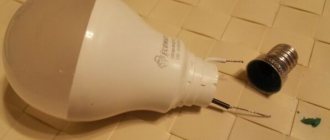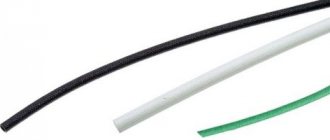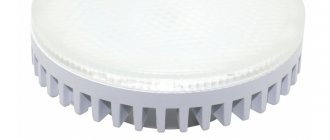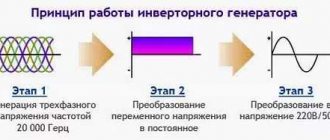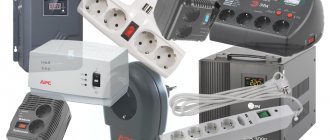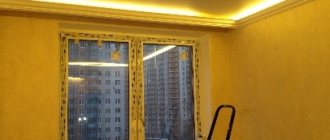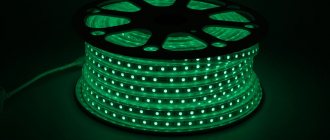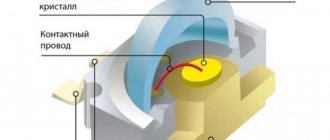- Operating voltage
LED strips are a unique light source that can realize the most daring ideas for organizing lighting scenarios.
Structurally, the LED strip is a flexible printed circuit board made of copper of compact dimensions - 2-3 mm high and 8-10 mm wide. LEDs with a dispersion angle of 120° are soldered to the board. The reverse side is equipped with a self-adhesive layer for installation on the surface of the base.
Scheme of the device of an open monochrome white tape
The flexibility and compactness of the tape gives it the widest functionality. It is indispensable for illuminating hard-to-reach places and limited spaces, and is used as a design accent to highlight ceiling structures, niches, steps, contour lighting of the floor and interior items. It is also used as an independent light source for cabinets, advertising structures, and transparent light panels.
Supply voltage
Voltage is of great importance in the power supply of any electronic product, therefore all types of LED strips are conditionally classified according to this parameter. Initially, tapes were produced only for a power supply unit (PSU) with an output voltage of 12V, but with the advent of powerful LEDs, the current load on printed conductors increased significantly, which caused their frequent overheating. The way out of the situation was the introduction of new nutrition standards:
- from DC power supply voltage 24V and 36V;
- from AC mains voltage 220V.
Tapes designed for power supply from a 220V AC network are connected via a rectifier. As a rule, the package includes a unified cable with a built-in diode bridge and a corresponding connector.
Explanation of symbols
Markings are applied to the tape, which encrypts all the necessary information. Let’s say it looks like “NLS-5050RGB60-14.4-IP20-12V-Pro R5”, the most important information in it is deciphered like this +:
- 5050 – type of LEDs SMD 5050 (LEDs for surface mounting in SMD housing 5x5 mm);
- RGB – multicolor;
- 60 – on the strip there are 60 LEDs per 1 linear meter (pcs/m);
- 14.4 – power of a segment 1 meter long is 14.4 watts;
- IP20 – class of protection against dust and moisture provided by the shell;
- 12V – supply voltage.
The remaining letters and numbers represent a series or designation of a specific product and each manufacturer has their own.
Advantages and disadvantages
Perhaps this statement looks pretentious, but the LED strip has practically no disadvantages. In fact, it is a unique light source that has no analogues. The tape not only occupies a separate niche, but also successfully competes with LED lamps in all areas of their application.
Advantages:
- flexibility of the structure, bending in two planes;
- no need for fasteners, sticks to the surface;
- homogeneous, uniform glow that cannot be created by other lighting devices;
- a huge range of brightness and colors of light output; possibility of flexible management;
- cutting into fragments of the required size for any distance.
Flaws:
- a separate power supply and a place to place it are required;
- it is necessary to lay the electrical wiring and connect it correctly;
- the image is negatively affected by the sale of cheap low-quality LED strips;
- It’s difficult to choose the right model and connect it correctly on your own.
Power consumption
To create a luminous flux, an LED consumes electrical power. Although the ratio of wattage to irradiance of an LED is much higher than that of an incandescent lamp, strip lights can draw significant current. It is defined:
- energy consumption of a single element (depending on its type);
- the number of LEDs installed on the strip (depending on the density of the location).
Examples of placement of LEDs with different densities and number of rows.
In practice, such a parameter as the power consumed by one meter of tape is important. When making calculations, lighting systems are based on this characteristic. There is no place for this parameter in the most common labeling, but some manufacturers take it seriously. Thus, one of the tapes produced under the Apeyron brand is designated Apeyron Electrics LSE-159 SMD 5050 30LED IP20 12V 7.2W 5 m. Here 7.2 W is the specific power consumption.
Degree of protection
Types of LED strips differ in the type of design, namely, the ability to withstand the negative effects of dust and moisture. The protection class is indicated on the packaging in the form of two numbers located after the abbreviation IP. For example, a tape with open mounting of parts is classified as IP20 and does not have any sealing. Conversely, fully insulated tape has the highest protection rating of IP68 and is designed to withstand normal operation in water.
The base of all LED strips is covered with an adhesive layer, which ensures reliable contact with most types of surfaces. When using a tape without a decorative profile, you need to pay attention to the color of its base, because when turned off, it will stand out from the general interior. Its backing can be white, gray, brown or have a transparent base.
In addition to the types of strips considered, manufacturers of LED products also produce products with wider capabilities. This includes LED kits for implementing complex dynamic effects and with the ability to synchronize for simultaneous control of several luminous areas.
Classification by glow color
The color shade of the glow is perhaps the first parameter in any LED product. According to this parameter, LED strips are divided into two groups: single-color and multi-color.
Single-color tapes, when powered, emit only one color, usually white, blue, red, yellow or green. But in addition to these primary colors, you can find specimens with a crimson, turquoise or purple glow. White ribbons are further subdivided based on color temperature (warm, neutral or cold). Among the non-standard options, it is worth noting products with ultraviolet and infrared glow. Multicolor strips are constructed using multi-chip LEDs, in which each crystal emits a strictly defined color. The most common are LEDs based on RGB and RGBW LEDs.
The abbreviation of English letters indicates the colors of the LEDs: R – red, G – green, B – blue, W – white.
Multicolor ribbons are connected through a special controller, which serves to regulate the power supply current of the color channels.
Light flow direction
In most cases, the luminous flux is directed across the plane of the canvas. But a situation may arise when it is necessary to illuminate the surface, and placing the tape strictly above it is problematic. Or you need to avoid a situation where the light hits a person’s eyes. Then a side-glow tape is used - its LEDs direct the main flow along the plane of the canvas, that is, along the surface on which the tape is glued.
Side (end) glow device.
Such LED strip in the most common marking is designated:
- RS – open version;
- RSW – hermetically sealed.
By sticking such a lamp on the wall, you can illuminate the steps without blinding people.
Main conclusions
The brightest modifications of LED strips are characterized by the following number of parameters:
- Manufacturer.
- Ice matrix type.
- Frequency of crystal arrangement.
- Color temperature and the ability to change it.
- Modification of the diffuser.
Depending on their combination, the lighting parameters of a particular product change. However, in addition to them, the brightness is also affected by the size of the ice element and how honestly the technologies were followed in the production of them and the LED strip based on them. Among the most popular brands of high-quality, brightest led strips are Sveteco, Elektrostandard, LEDCraft, Era, Arlight, Joliet Technologies, Feron and some others.
If you know other modifications of the brightest LED strips, their features and scope of application, be sure to share such useful information in the comments.
